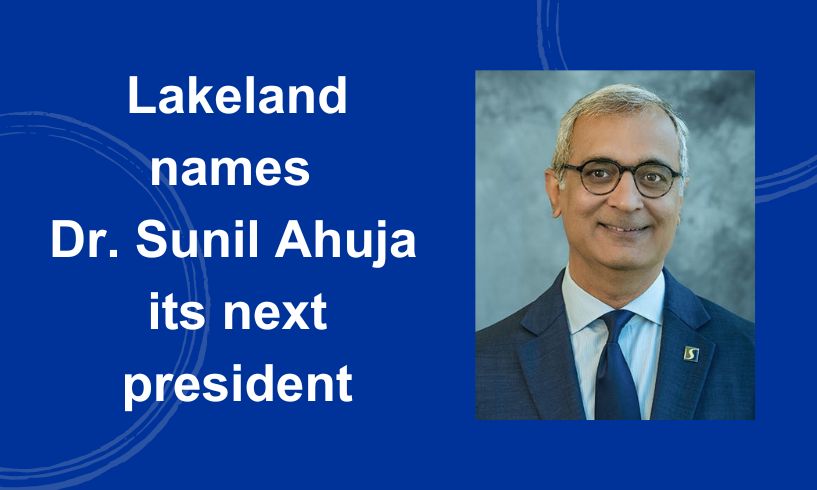By Brian Massie, A Watchman on the Wall

Dr. Ahuja outlined his preliminary goals for Lakeland Community College.
#1 Goal – Ensuring financial sustainability and following the State Auditor’s recommendation in their performance audit.
In speaking to Lake County citizens about the plight of Lakeland, the following ideas or suggestions were proffered:
- Meet with business leaders and, if needed, redefine the mission of Lakeland to ensure it is in keeping with what is needed by the local businesses -students should not need to travel to other community colleges, if there is a great demand for the course, because the course is not offered at Lakeland.
- Institute vocational training of all types.
- Meet with all of the school districts in Lake County to ensure that students know what courses are offered at Lakeland.
- Determine why all Lake County School Districts are not using Lakeland’s facilities.
- Determine if there is any synergy between Lakeland and Auburn Career Center and eliminate duplication of services.
- If the local school districts cannot or will not do the needful to bring students to grade level with their basic education, can Lakeland provide those services?
- Prohibit Lakeland from accept a new High School graduate who is not eligible to enroll in for credit classes. Lakeland should be working with area schools to communicate this and apply pressure to ensure the graduates are ready for college work.
We look forward to observing the necessary changes that will be required to get Lakeland back on the road to financial sustainability, and being a more willing partner with business and educational community in Lake County.

To Ellen Foley Kessler and the entire Board of Trustees: We are rooting for you to be good stewards of the taxpayers money, and returning Lakeland to the top Community Colleges in Ohio.
Updated May 8, 2024
The following is from the State of Ohio’s Auditor, Keith Faber’s, performance audit on the College:
WHAT WE FOUND
Many key operational decisions regarding faculty, programs, and facilities, date back to the early 2010s during a time of peak enrollment. Since that point in time, the College has seen enrollment decline by nearly 50 percent, but the administration has not made decisions to reflect the changes in operations. Staffing has not been significantly reduced, new facilities have been acquired, and courses are being held with minimal enrollment.
Based on projected population trends, it is highly unlikely to see significant increases in enrollment over the next decade. Due to this, the Board of Trustees is at a point in time where key operational decisions should be made to guide the college
into the next decade.
The College has historically maintained low fund balances, opting to use available funds on direct student services. This policy does not provide a significant cushion to weather times of difficulty, such as incurring unforeseen expenses or sudden declines in revenue. We found that, in recent years, without federal relief funds due to the COVID-19 pandemic, the College would have had an operating deficit
and been more reliant on fund balances for general expenditures.
Overall, we found that LKCC leadership, both the Board of Trustees and the administration, will need to come together and make strategic management decisions to ensure the continued operations of the College. When informed with critical information identified within the report, these individuals will be in a better position to make key strategic decisions.
KEY OBSERVATIONS
Key Observation 1: The College relies on public funds – local property taxes and state funding – for the majority of its operational revenue. As such, the Board and Administration must work to be good stewards of public resources and ensure decisions are made to reflect the changing landscape of higher education and the local area. We found that the College has failed to make major operational adjustments as enrollment has steadily declined over the past decade. As a result, based on current enrollment, the college is overstaffed, burdened with debt related to facilities that are significantly underutilized, and is offering hundreds of course sections that do not meet minimum enrollment thresholds each semester.
Key Observation 2: During the engagement, members of the Board of Trustees reported that they were unaware of the deteriorating financial condition of the College. Additionally, the Board lacked insight into key operational decisions. As the main governance body for LKCC, the Board must obtain appropriate information from the administration to understand the current status of the College’s operations. Further, it must identify proactive solutions that can help to align operations
with the current market conditions of Lake County.
Key Observation 3: As enrollment declines, revenue from student tuition and state funding will also likely decline, which will lead to potential budget issues if expenditures are also not reduced in a similar manner. However, while other community colleges have seemingly reacted to changes in enrollment trends, the administration at LKCC has not similarly adapted its operations. As such, the
student to teacher ratio at LKCC is significantly lower than the statewide community college average.
Key Observation 4: The college has a total of 4,476 seats on the campus in various classroom and laboratory settings. During the 2023 Spring semester, the total student enrollment dropped below this number. Further, one third of students attended courses exclusively online and did not require any classroom space. Considering that the entire student body would never be attending classes at
the same time due to scheduling, the number of classroom and laboratory spaces maintained by the College greatly exceeds the demand of the student body.
Key Observation 5: Based on our analysis, nearly half of the classroom and laboratory space at LKCC is considered underutilized based on industry standard criteria. The buildings on the main campus are interconnected with each other. This building design makes the elimination or mothballing of existing space challenging. Despite this low utilization rate, declining enrollment, and shift to online learning, the College recently broke ground on a 16,000-foot expansion on the main campus. Choosing to expand its campus outwards rather than addressing the existing
space that is underutilized may further exacerbate issues related to maintaining excessive classroom and facilities space.
Key Observation 6: The Holden University Center was purchased by LKCC in 2014 for $13.5 million through the issuance of bonds. The purpose of the building was to host programs offered by four-year institutions. During the course of the audit, the Holden Building was mothballed by the College, meaning that it is no longer in use and any programs being held were moved to facilities on the main campus. While the College will eliminate some expenditures related to the operation of the Holden University Center there is still outstanding debt related to the purchase of the building, which will be fully paid in 2039. The building is separated from the main campus by a major roadway, and the College should consider options related to the sale or lease of this building.
Key Observation 7: Because of the choices that were, or were not made, over the past decade, the College finds itself at the precipice of fiscal watch, and in fact had to institute a reduction in force during the engagement. The Board and Administration have the opportunity to work together to make decisions to align operations to meet current demand for services and guide the College over
the next decade. Difficult choices regarding staffing levels, program offerings, and other operations may need to be made during this process but will ultimately help to ensure the sustainability of the College into the future.
Categories: Lakeland Community College, Uncategorized
